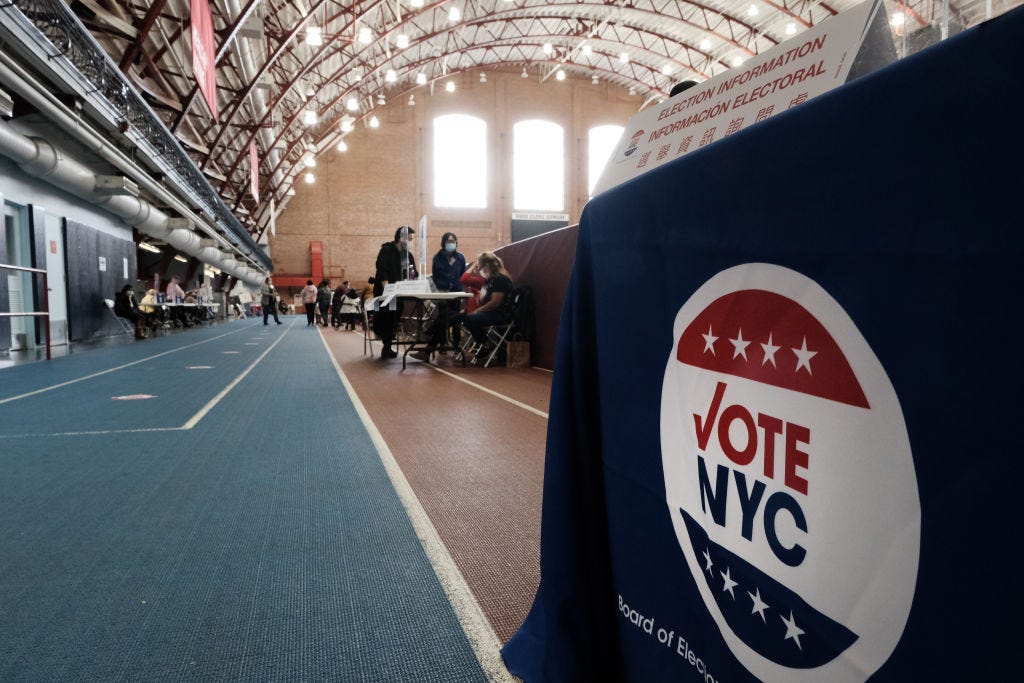UP TO YOU: One person, five votes
Can New York City's ranked-choice-voting experiment stop Andrew Cuomo?
Can an experimental program called ranked-choice voting improve democracy? Today in The Ink, journalist and author Nate Schweber dives deep on how it’s playing out in New York City.
He talks about the city’s use of ranked-choice voting, which aims to provide a fairer, less polarized election experience and to enable voters to choose according to their conscience with less risk of backing a spoiler in a close race. He also looks into how the Working Families Party is gearing up to elect a progressive to lead the city, and the DREAM campaign that seeks to deny former governor Andrew Cuomo a ranking (and to keep both Cuomo and current Mayor Eric Adams from winning office in November). Read on for more of Schweber’s stories from the campaigns.
By Nate Schweber
Come June, you might see another name on the ballot in the New York City mayoral election alongside the Democratic candidate, the Republican candidate, and a pair of candidates running as independents: the Working Families Party candidate.
It all depends on how the party and New Yorkers adapt to ranked choice voting, which will be used for the first time in a city mayoral race. The party made headlines last month by endorsing four progressive candidates: New York State Assemblyman Zohran Mamdani, New York City Comptroller Brad Lander, New York City Council Speaker Adrienne Adams, and New York State Senator Zellnor Myrie, in a prelude to supporting one of those candidates in the primary, Jasmine Gripper, co-director of the left-leaning party, said.
In the past, Working Families has endorsed the Democratic nominee to beat the Republican candidate. That probably won’t be the case if this year’s Democratic winner is former governor Andrew Cuomo, Gripper said.
Last week, Brad Lander told the New York Post he would not, under any circumstances, support Cuomo. Which raises a question: if Lander — or whichever candidate Working Families endorses in May — fails to win the Democratic primary, would that person run separately on the ballot on the party’s line?
When asked specifically if that would happen, Gripper was understanding, but noncommittal.
“I’m not surprised by Brad’s response – Andrew Cuomo has a history of harming New York City,” she said. “We’ll see the results of the primary, and we’ll see who we put on our line.”
New Yorkers approved ranked choice voting in 2019, a system in which voters can list as many as five candidates in order of most to least favorite. This lets voters rank a beloved candidate first and a more strategic candidate second, removing worries about whether the former would play the role of “spoiler” to the latter. (The question of Ralph Nader’s role in Al Gore’s loss in 2000 still casts a long shadow.)
If in the first round of counting no candidate receives more than 50 percent of top-ranked votes, the one with the fewest votes is eliminated, and votes for that person go in the next round to the candidate each voter ranked next. Rounds continue until one candidate gets more than 50 percent. Ranked choice has been adopted in many dozens of American cities as well as the states of Alaska and Maine. In New York, it is used only for primary and city council elections, not the general election in November. Critics say it adds complexity that could drive down turnout, and counting votes takes longer. Proponents say it gives voters more choice and results in less polarized races.




